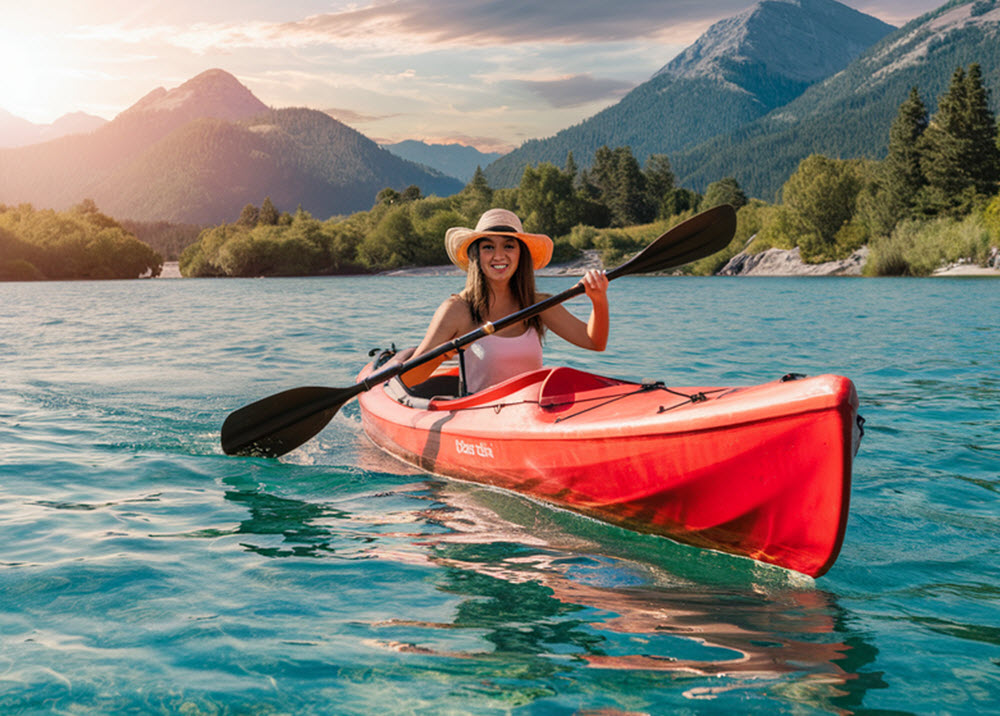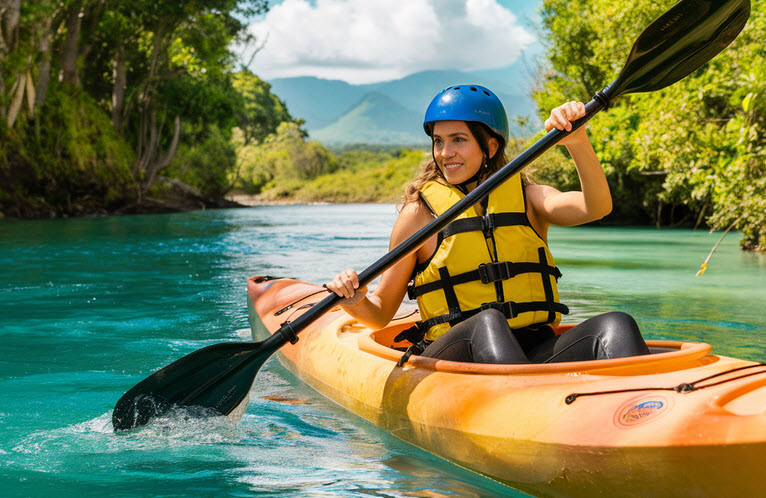Contents
Kayaking is a thrilling and versatile water sport that caters to a wide range of interests, whether you’re seeking a serene paddle on a calm lake, an adventurous journey down a rushing river, or a marine expedition along a scenic coastline. It’s a sport that combines physical activity with the opportunity to explore nature, wildlife, and often inaccessible areas, all from the unique vantage point of a small, sleek watercraft.
Kayaking offers a unique blend of adventure, fitness, and tranquility, appealing to a wide range of interests and skill levels. Whether it’s the peaceful solitude of a sunrise paddle, the camaraderie of a group expedition, or the adrenaline rush of navigating rapids, kayaking provides an enriching way to connect with the water and the natural world. So, grab a paddle, don a life jacket, and embark on your own kayaking adventure to see where the water takes you.

The word kayak originates from the Greenlandic word qajaq. Several people indigenous to the region, including the Aleuts, Inuits and Yupiks, have long traditions of using qajaqs and the term is spelled a bit differently from one language to the other, e.g. iqyax in Aleut and quayaq in Yupik.
The basics of kayaking
1. Types of kayaks: Kayaks come in various shapes and sizes, each designed for specific water conditions and activities. There are sea kayaks for ocean adventures, whitewater kayaks for river rapids, recreational kayaks for leisurely paddles on calm waters, and inflatable kayaks for easy transportation and storage. It is advisable to use a kayak that is suitable for both your planned trip and your skill level.
2. Getting started: Beginners should start with calm, sheltered waters and potentially take a kayaking course to learn the basics. Essential skills include paddling techniques, how to enter and exit a kayak, and basic safety practices.
3. Safety: Always wear a life jacket, regardless of your swimming abilities. Checking weather conditions before heading out, knowing your route, and kayaking with a buddy are also good safety measures.
Understanding the kayak tradition
As mentioned above, several peoples have a long tradition of using kayaks, including the Aleut, Inuti and Yupik peoples who having been using these boats to hunt in the waters of the North Atlantic, Arctic Ocean, Bearing Sea and North Pacific regions, including not just coastal areas but also rivers and inland lakes.
Early kayaks were made from animals skins, especially seal skins, stretched over a frame made from wood or whalebone-skeleton – depending on what was available. Western Alaskan peoples did for instance have better access to wood than the eatern Inuits.
A kayak created for the personal use of one specific hunter was typically made by the man himself and his wife, and designed to fit his specific size perfectly in order to increase maneuverability. In the kayak, the hunter would wear a special garnment stretched over the coaming´s rim and sealed with drawstrings. It would also be sealed at the wrist and the hood edges, to further limit the mount of water that would enter if the kayak capsized.
Kayaks are believed to have been used for at least 4,000 years. The oldest extant kayak is from 1577 and is now kept in the North America Department at the State Museum of Ethnology in Munich, Germany.
Different purposes and designs
Early kayaks were made to various desings to suit the needs of the people using them, and knowledge of how to build and utilize kayaks were passed down both through practical use and through oral traditions. Some kayaks were for instance created to be large enough to carry passangers and goods, while many was for a single hunter only.
Examples of traditional kayaks:
- The baidarkas from the Bering Sea & Aleutian Islands. They have a rounded shape and numerous chines. This is believed to the be oldest kayak design.
- The West Greenland kayaks, which have a more angular shape and not as many chines. Gunwales rise to a point at the bow and stern.
- The East Greenland kayaks. They are quite similar to the West Greenland kayaks, but tend to fit the user more snuggly. The angle between gunwale and stem is comparativley steep, to increase maneuverability.
Why is kayaking such a popular hobby today?
1. Accessibility: Kayaking is relatively easy to learn. Equipment rentals and lessons are available at many local parks, lakes, and coastal areas. It’s suitable for many different ages and fitness levels, making it a family-friendly activity.
2. Health benefits: It’s an excellent workout that combines aerobic exercise with strength training, for both the upper body, core, and legs. The motion of paddling can also be meditative, offering mental health benefits.
3. Connection with nature: Kayaking allows for intimate encounters with nature and wildlife, from gliding past wildflowers on a riverbank to watching dolphins play in the waves. It offers a quiet, eco-friendly way to explore and appreciate the outdoors.
4. Adventure and exploration: For the adventurous spirit, kayaking opens up a world of exploration. Paddle through untouched wilderness, navigate whitewater rapids, or embark on multi-day sea kayaking expeditions to remote islands.

Tips for a better kayaking experience
1. Choose the right kayak: Consider the type of kayaking you plan to do and select a kayak that fits your needs. Rental facilities can offer advice and allow you to try different models.
2. Learn basic techniques and safety: Proper paddling technique will make your experience more enjoyable and less tiring. Familiarize yourself with safety practices, including how to right yourself if you capsize. Always tell someone your planned route and expected return time.
3. Pack smart: For longer trips, do not forget to pack essentials like water, snacks, sunscreen, a physical map, and necessary personal items. A dry bag is recommended for water-sensitive objects. It is possible to capsize even in calm waters.
4. Respect the environment: Practice “Leave No Trace” principles by avoiding disturbing wildlife and not leaving any trash behind. Be mindful of the ecosystem and other water users.
5. Join a community: Many areas have kayaking clubs or groups that organize outings, which can be a great way to meet fellow enthusiasts and discover new kayaking locations.
